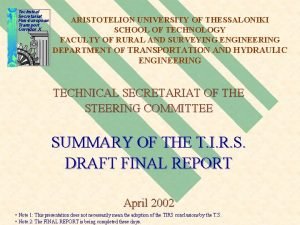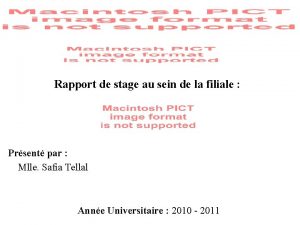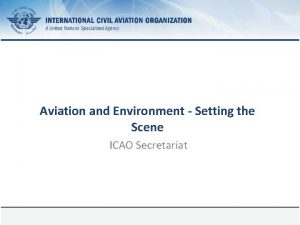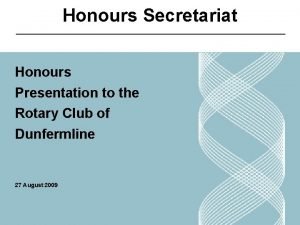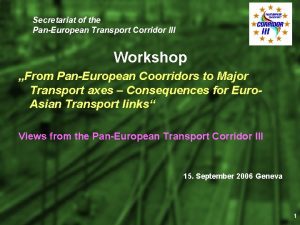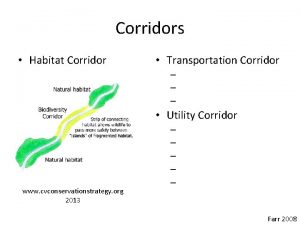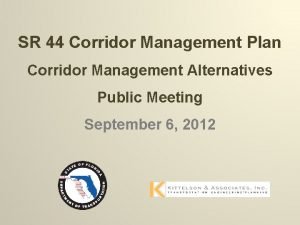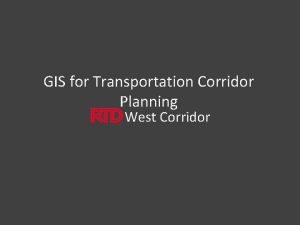Technical Secretariat PanEuropean Transport Corridor X ARISTOTELION UNIVERSITY











- Slides: 11

Technical Secretariat Pan-European Transport Corridor X ARISTOTELION UNIVERSITY OF THESSALONIKI SCHOOL OF TECHNOLOGY FACULTY OF RURAL AND SURVEYING ENGINEERING DEPARTMENT OF TRANSPORTATION AND HYDRAULIC ENGINEERING TECHNICAL SECRETARIAT OF THE STEERING COMMITTEE SUMMARY OF THE T. I. R. S. DRAFT FINAL REPORT April 2002 • Note 1: This presentation does not necessarily mean the adoption of the TIRS conclusions by the T. S. • Note 2: The FINAL REPORT is being completed these days.

INTRODUCTION Ø TIRS (Transport Infrastructure Regional Study for the Balkan Region) is financed by Agence Française de Développement in the context of the Stability Pact and supervised by a steering group including: the European Conference of Ministers of Transport acting as chairman of the Steering Group and monitoring the study the European Commission the European Investment Bank the French Ministry of Transport. The Consultant commissioned to carry out the study is Louis Berger S. A. Ø The study is a critical review of existing plans and programmes which respective Authorities in the Balkan region have as their basis for infrastructure improvements in response to defined objectives for transport development in their countries. The participating countries are: Albania, Bosnia and Herzegovina, Bulgaria, Croatia, F. R. Yugoslavia, F. Y. R. O. M. , Romania. Ø The countries individual requests for transport infrastructure investments are of a different nature and refer to substantially different types of projects. The national objectives, which regularly appear are: Reconstruction of destroyed or damaged facilities, q Rehabilitation of existing facilities severely deteriorated by lack of maintenance, q Upgrading main facilities to offer improved levels of service, q Development of substantial and modern transport infrastructure on the main communication axis to meet expected long-term requirements. q Ø F. R. Yugoslavia has the first two objectives in mind, attempting to upgrade facilities as far as possible; Bulgaria is concerned by the two last objectives whereas Croatia mainly shows concerns of the fourth category of objective. F. Y. R. O. M. is concerned mainly by objective 2 and 3.




TRANSPORT INFRASTRUCTURE OBJECTIVES Ø The report suggests that at the level of the region as a whole, and in line with the Terms of Reference of TIRS, specific transport infrastructure objectives could be expressed as follows: q Raise or keep the transport communication system between the main economic and demographic centres in the region at technical standards and with the quality of service required by transport demand, q Facilitate, improve and shorten whenever possible the connections between different national transport networks, q Facilitate access to the region and transit through the region, of foreign traffic, with required standards of comfort and safety, q Rationalise, simplify and accelerate the procedures at border crossings throughout the region, q Introduce inter-regional agreements to co-ordinate development of the main transport infrastructure and to improve transport services by jointly operating equipment or rolling stock whenever feasible.

RESULTS – COMMENTS OF THE STUDY (1/2) Ø Capacity considerations of existing infrastructure have been examined and have generally concluded that there are no physical bottlenecks on surface transportation networks at present with the exception of a couple of bridges destroyed or damaged in Yugoslavia. ROAD Ø Traffic congestion is however expected to become a nuisance in the medium term, but only on a few sections of the highway network, namely: q on Corridor IV between Sofia and the Greek border, and on the E 763 road between Belgrade and Cacak, along the roads servicing the Adriatic coast in Croatia, between Zagreb/ Rijeka and Split, q on Corridor X between Belgrade and Hungary and between Leskovac and Kumanovo, q near the largest cities, like Bucharest, Sofia, Belgrade and Sarajevo. Ø All of the links listed above should require upgrading to four lanes expressway/motorways in the medium term. Other localised congestion throughout the region should largely be reduced by

RESULTS – COMMENTS OF THE STUDY (2/2) RAIL Ø Railway lines should not experience any noticeable increase in traffic, and those lines which are already close to their capacity could, with some minor adaptations in signalling and crossings, handle higher levels of traffic if necessary. Given the unclear prospects for rail transportation in the region and the generally poor financial situation of the railway companies, rail infrastructure development strategy should remain modest for the moment and concentrate on the most trafficked links, basically those existing along the Pan European Transport Corridors. Ø Systematic rehabilitation and progressive upgrading of these lines should allow railway transportation to have a chance to play its role and to protect its natural markets. Ø Major investments, such as those which may lead to a significant increase in the nominal minimum speed, or doubling or electrifying tracks, should be carefully analysed. Ø The financial situation of the railways has to improve in most cases or be adequately managed before more important and long-term

SPECIFIC COMMENTS ON CORRIDOR X (1/2) IN GENERAL Ø Corridor X was clearly the most utilized route across the region ten years ago. The stabilization of the situation and the recent political changes have already allowed the Corridor to take back part of its original traffic which had been diverted to other competitive routes. The classification of all projects envisaged along this corridor concur to a systematic rehabilitation and upgrading of this corridor in the middle term, for both road and railway infrastructures, on the main corridor route. ROAD (/…) Ø At the Southern end of the corridor, the construction of a two-lane carriageway with motorway characteristics on Demir Kapija – Udovo – Gevgelija in F. Y. R. O. M. (project Ma-H-05 – Construction of a 44, 5 km new carriageway – Estimated cost: 54 million Euro) will allow to handle the expected traffic for some time before completing a fully fledged motorway.

SPECIFIC COMMENTS ON CORRIDOR X (2/2) ROAD (…/) Ø Upgrading of only one section on the road infrastructure may be postponed for a while, in waiting for higher traffic levels to be reached: Slavonski Brod – Lipovac/ project Cr-H-07 (Construction of a 26 km motorway close to the FRY border – Estimated cost: 125 million Euro) in Croatia. Ø Branch Xb should be completed as a standard motorway. Ø Conversely, branch Xc (Nis – Pirot – Sofia/ Estimated cost: 15, 5 million Euro) should be upgraded to a standard two lane highway, without moving immediately to motorway standards (such perspective should be analysed for branch Xc in a pre-feasibility study to be conducted during TIRS 2). Ø Branch Xd necessitates only some local upgrading. RAIL Ø Progressive rehabilitation and upgrading of the railway line is recommended on the trunk corridor, from Yugoslavian/ Hungarian

PERSPECTIVES Ø The full value of many infrastructure projects will only be realised if institutional or bilateral/multilateral arrangements are reached in the meantime. This is the case – inter alia – for: q The recognition of an international status for the Sava river and a distribution of responsibilities among the riparian countries is made for its maintenance and operations, q The facilitation and speeding-up of border crossing operations in general, but in particular for railway transport, with a single control point for cargo and custom control on line for passengers. Ø The European Commission has prepared the detailed terms of reference for a second phase for TIRS. It is envisaged that Phase 2 will include, amongst other actions, the conduct of some prefeasibility studies and selective prospective analysis, the development of an appropriate information system at regional level and assistance in the creation of a documentation centre to ensure that the most important information or documentation on the transport system of the Balkans is retained and made accessible for future users.
 Trans kalahari corridor secretariat
Trans kalahari corridor secretariat Aristotelion
Aristotelion Public appointments secretariat
Public appointments secretariat Rapport de stage
Rapport de stage Honours and appointments secretariat
Honours and appointments secretariat Digital secretariat cg
Digital secretariat cg Icao
Icao Literacy and numeracy secretariat
Literacy and numeracy secretariat Institute of secretariat training and management
Institute of secretariat training and management Honours secretariat
Honours secretariat Secretariat family tree
Secretariat family tree Pacific island forum secretariat
Pacific island forum secretariat

